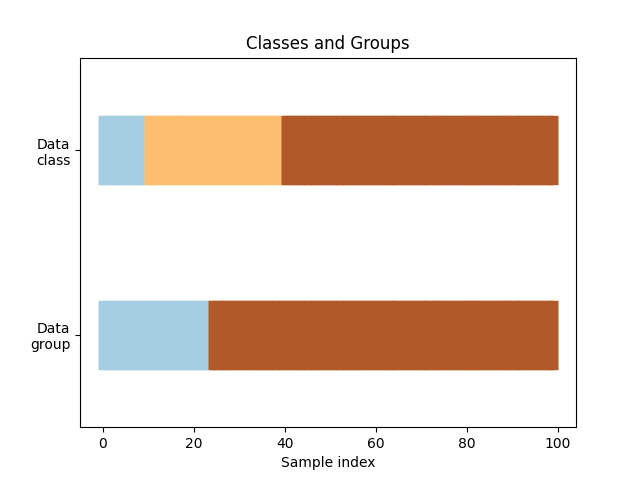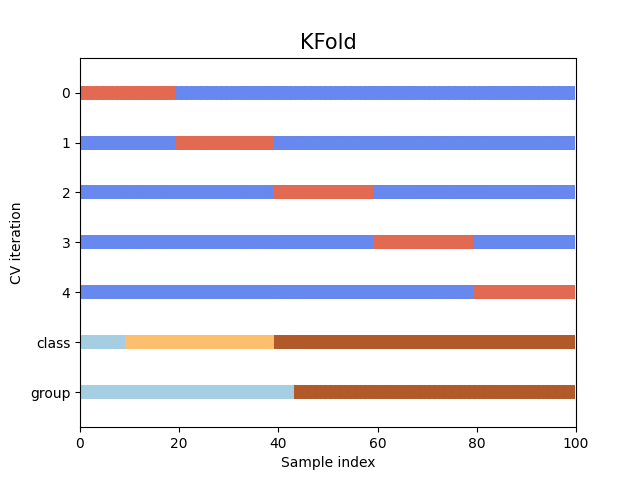机器学习中交叉验证行为的可视化(scikit-learn) 交叉验证(cross-validation)是一种用于评估机器学习模型性能的统计学方法。它通过将数据集划分为多个互不重叠的子集,然后利用其中一部分数据作为训练集,另一部分数据作为试集来训练和测试模型。这个过程会进行多次,每次使用不同的子集作为测试集,最终计算模型在不同测试集上的性能指标。交叉验证可以有效地评估模型的性能和泛化能力,避免模型在特定数据集上过度拟合或欠拟合的情况,同时也可以帮助选择最佳的模型超参数,如学习率、正则化参数、网络层数等。
为了验证交叉验证行为的正确性,我们可以对交叉验证过程中划分好的数据集进行可视化,来直观的对交叉验证进行观察。我们以scikit-learn实现的k-fold交叉验证为例,来实现对交叉验证行为的可视化。
生成虚拟数据 首先我们需要生成一些虚拟的数据。这些数据用来模拟一个常见的机器学习分类任务的数据集,例如:一个三分类的疾病分类任务,三种类别的疾病分布在人群中,这个人群分为“男”、“女”两个“组”,三种类别的数据均匀的分布在两个组中。我们随机生成100个数据点,这个生成的数据集中有三个类别,这三个类别不均匀的分布在数据集中,但是均匀的分布在两个组中。
1 2 3 4 5 import matplotlib.pyplot as pltimport numpy as npfrom matplotlib.patches import Patchfrom sklearn.model_selection import KFold
编写生成数据的函数generate_data(),其中n_points为生成的数据点个数,n_features为生成数据的特征数,n_groups为分组数,percentiles_classes为每种类别所占的比例。
1 2 3 4 5 6 7 8 9 10 11 12 13 def generate_data (n_points: int = 100 , n_features: int = 10 , n_groups: int = 2 , percentiles_classes: list [float ] = None ) -> tuple : if percentiles_classes is None : percentiles_classes = [0.1 , 0.3 , 0.6 ] X = np.random.randn(n_points, n_features) y = np.hstack( [[i] * int (100 * perc) for i, perc in enumerate (percentiles_classes)]) group_prior = np.random.dirichlet([2 ] * n_groups) groups = np.repeat(np.arange(n_groups), np.random.multinomial(n_points, group_prior)) return X, y, groups
数据分组可视化 接下来,实现一个数据可视化的的函数visualize_data来帮助我们直观的观察到数据中的类别以及组的分布情况。
1 2 3 4 5 6 7 8 9 10 11 12 13 14 15 16 17 18 19 20 21 22 23 24 25 26 27 28 def visualize_data (classes: np.ndarray, groups: np.ndarray, name: str = 'Classes and Groups' ) -> None : fig, ax = plt.subplots() ax.scatter( range (len (groups)), [0.5 ] * len (groups), c=groups, marker="_" , lw=50 , cmap=plt.cm.Paired, ) ax.scatter( range (len (groups)), [3.5 ] * len (groups), c=classes, marker="_" , lw=50 , cmap=plt.cm.Paired, ) ax.set ( ylim=[-1 , 5 ], yticks=[0.5 , 3.5 ], yticklabels=["Data\ngroup" , "Data\nclass" ], xlabel="Sample index" , ) ax.set_title(name) plt.show()
通过调用上面的函数,我们可以观察到我们生成的数据的分组情况,三个类别与两个组并不是均匀的分布在整个数据集中:
可视化交叉验证行为 接下来,我们定义一个函数来可视化交叉验证行为。该函数允许我们传入一个交叉验证的对象,并且对其所划分的测试机与验证集进行直观的展示。
1 2 3 4 5 6 7 8 9 10 11 12 13 14 15 16 17 18 19 20 21 22 23 24 25 26 27 28 29 30 31 32 33 34 35 36 37 38 39 40 41 42 43 44 45 46 47 48 49 50 51 52 53 54 55 56 def visualize_cv (cv, X: np.ndarray, y: np.ndarray, group: np.ndarray, n_splits: int = 5 , lw: int = 10 ) -> None : fig, ax = plt.subplots() use_groups = "Group" in type (cv).__name__ groups = group if use_groups else None for ii, (tr, tt) in enumerate (cv.split(X=X, y=y, groups=groups)): indices = np.array([np.nan] * len (X)) indices[tt] = 1 indices[tr] = 0 ax.scatter( range (len (indices)), [ii + 0.5 ] * len (indices), c=indices, marker="_" , lw=lw, cmap=plt.cm.coolwarm, vmin=-0.2 , vmax=1.2 , ) ax.scatter( range (len (X)), [ii + 1.5 ] * len (X), c=y, marker="_" , lw=lw, cmap=plt.cm.Paired ) ax.scatter( range (len (X)), [ii + 2.5 ] * len (X), c=group, marker="_" , lw=lw, cmap=plt.cm.Paired ) yticklabels = list (range (n_splits)) + ["class" , "group" ] ax.set ( yticks=np.arange(n_splits + 2 ) + 0.5 , yticklabels=yticklabels, xlabel="Sample index" , ylabel="CV iteration" , ylim=[n_splits + 2.2 , -0.2 ], xlim=[0 , 100 ], ) ax.set_title("{}" .format (type (cv).__name__), fontsize=15 ) plt.show() cv = KFold(5 ) visualize_cv(cv, X, y, groups, 5 )
我们以一个5折交叉验证为例,5折交叉验证的cv对象会将原始数据集分成五个相等大小的子集(或折叠fold),其中四个子集用于训练模型,而剩下的一个子集用于测试模型。这个过程重复五次,每次选择不同的一个子集作为测试集,其余的作为训练集。最后,将五次的性能评估结果取平均值以得到最终评估结果。最终的可视化结果如下:
可以直观地看到,在默认情况下,KFold 交叉验证迭代器不考虑数据点类别或组。
通过这种方式,可以直观地让我们对包含多个类别与组的数据分布进行观察,同时以直观的方式观察交叉验证行为,方便我们对交叉验证行为的正确性进行初步的检验。

